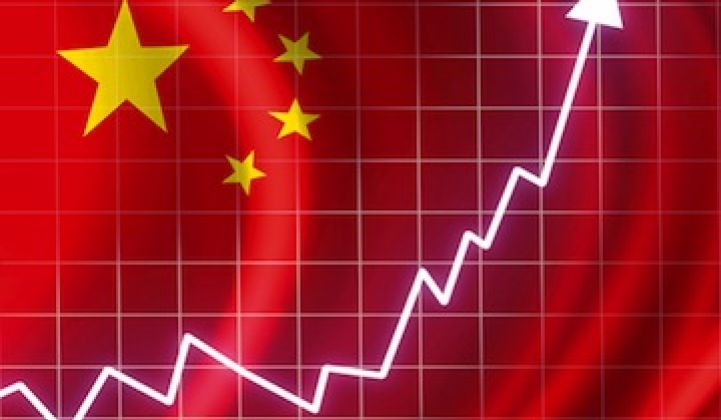The writing has been on the wall for a while, and China seems to be getting the message that the only way its solar sector can avoid a complete meltdown is if the country radically increases domestic deployment: Photovoltaic solar hooked in with China State Grid, the country’s largest grid operator, jumped from 530 megawatts to 2.71 gigawatts in the twelve months ending Sept. 30, according to the State Electricity Regulatory Commission.
That capacity increase of more than 400 percent was impressive enough, but actual PV power flowing to the grid grew at an even faster rate, rocketing up 537 percent in the same period to 2,480 gigawatt-hours.
China’s solar manufacturing sector rose from nothing to dominate the globe in the past five years, flooding fast-growing markets like Europe and the U.S. with cheap solar panels. But many of those markets have begun to tighten as government incentives dry up, and also as the U.S. moves toward duties on Chinese imports and Europe probes price-dumping allegations.
The result, for the Chinese industry, is extraordinary overcapacity. GTM Research reports that China’s c-Si PV module ramped manufacturing capacity hit 48.02 gigawatts in 2012, outstripping the forecast of 31.3 gigawatts for 2012 global installations. A recent article in the Communist Party-connected China Daily put China’s manufacturing capacity even higher, at 50 gigawatts. The article reported that 90 percent of China’s PV products are made for export, with about 60 percent aimed at Europe and 30 percent at the U.S.
So dire has the situation become that even China’s biggest panel maker (also the biggest panel maker in the world), Suntech Power Holdings, has needed emergency funding from the government in the city of Wuxi, where Suntech is headquartered, to stay afloat. The giant wafer-maker LDK Solar has also gotten state help, selling a 20 percent stake to state-run Hen Rui Xin Energy for $23 million, BusinessWeek reported.
But the biggest priority now, from Beijing’s perspective, seems to be to spur increases in solar deployment. Xinhua reported in September that Beijing had asked provincial leaders to “make plans for establishing distributed photovoltaic generation demonstration centers as part of efforts to boost the domestic solar industry amid mounting trade frictions with the United States and the European Union.” Last week, the State Grid Corporation of China announced a plan to allow small-scale distributed solar power generators to connect to power lines. All told, China Daily said, the country is planning to spend some $11 billion to boost domestic deployment.
Integrating vast amounts of solar can be challenging, but in July, China said it would boost its target for solar energy installation to 21 gigawatts in the current five-year plan, which runs through 2015. Some analysts think 50 gigawatts might be possible -- and maybe even 100 gigawatts.
***
Editor's note: This article is reposted in its original form from EarthTechling. Author credit goes to Pete Danko.



